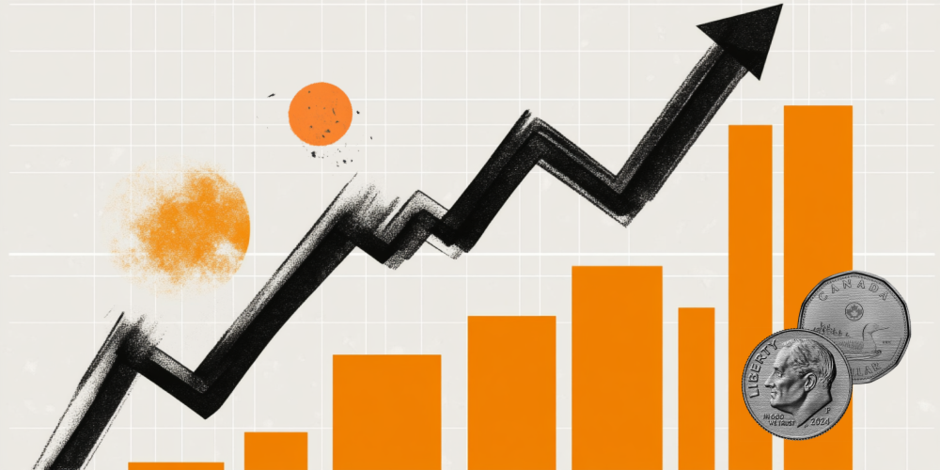USD/CAD jumps to near two-decade high, around mid-1.4700s on Trump’s trade tariffs
- USD/CAD rallies hard in reaction to Trump’s trade tariffs on Canada, Mexico, and China.
- The risk-off impulse lifts the USD back closer to a two-year top and weighs on the major.
- The divergent BoC-Fed policy outlooks contribute to the momentum and favor bulls.

The USD/CAD pair builds on last week's breakout momentum above a short-term trading range and gains strong positive traction during the Asian session on Monday. The momentum lifts spot prices to mid-1.4700s, or the highest level since April 2003, and is sponsored by the launch of US President Donald Trump's tariff trade war.
Trump on Saturday ordered 25% tariffs on Canadian and Mexican imports and 10% on goods from China starting on Tuesday and declared that they would remain in place until the countries stem the flow of illegal drugs and immigrants into the US. The announcement tempers investors' appetite for riskier assets and provides a strong boost to the safe-haven US Dollar (USD). In fact, the USD Index (DXY), which tracks the Greenback against a basket of currencies, jumps back closer to over a two-year top touched in January and acts as a tailwind for the USD/CAD pair.
The Canadian Dollar (CAD), on the other hand, is weighed down by the Bank of Canada's (BoC) dovish move last week, to cut interest rates for the sixth time in a row since June and announced an end to its quantitative tightening program. This marks a big divergence in comparison to the Federal Reserve's (Fed) hawkish pause, which favors the USD bulls and suggests that the path of least resistance for the USD/CAD pair remains to the upside. Adding to this, the recent decline in Crude Oil prices validates the near-term negative outlook for the commodity-linked Loonie.
US Dollar PRICE Today
The table below shows the percentage change of US Dollar (USD) against listed major currencies today. US Dollar was the strongest against the Australian Dollar.
| USD | EUR | GBP | JPY | CAD | AUD | NZD | CHF | |
|---|---|---|---|---|---|---|---|---|
| USD | 1.29% | 0.97% | 0.47% | 0.24% | 1.53% | 0.85% | 0.05% | |
| EUR | -1.29% | 0.09% | 0.49% | 0.26% | 0.70% | 0.87% | 0.08% | |
| GBP | -0.97% | -0.09% | -0.71% | 0.17% | 0.62% | 0.78% | -0.01% | |
| JPY | -0.47% | -0.49% | 0.71% | -0.22% | 1.21% | 1.30% | 0.23% | |
| CAD | -0.24% | -0.26% | -0.17% | 0.22% | 0.19% | 0.61% | -0.18% | |
| AUD | -1.53% | -0.70% | -0.62% | -1.21% | -0.19% | 0.17% | -0.62% | |
| NZD | -0.85% | -0.87% | -0.78% | -1.30% | -0.61% | -0.17% | -0.80% | |
| CHF | -0.05% | -0.08% | 0.01% | -0.23% | 0.18% | 0.62% | 0.80% |
The heat map shows percentage changes of major currencies against each other. The base currency is picked from the left column, while the quote currency is picked from the top row. For example, if you pick the US Dollar from the left column and move along the horizontal line to the Japanese Yen, the percentage change displayed in the box will represent USD (base)/JPY (quote).
Tariffs FAQs
Tariffs are customs duties levied on certain merchandise imports or a category of products. Tariffs are designed to help local producers and manufacturers be more competitive in the market by providing a price advantage over similar goods that can be imported. Tariffs are widely used as tools of protectionism, along with trade barriers and import quotas.
Although tariffs and taxes both generate government revenue to fund public goods and services, they have several distinctions. Tariffs are prepaid at the port of entry, while taxes are paid at the time of purchase. Taxes are imposed on individual taxpayers and businesses, while tariffs are paid by importers.
There are two schools of thought among economists regarding the usage of tariffs. While some argue that tariffs are necessary to protect domestic industries and address trade imbalances, others see them as a harmful tool that could potentially drive prices higher over the long term and lead to a damaging trade war by encouraging tit-for-tat tariffs.
During the run-up to the presidential election in November 2024, Donald Trump made it clear that he intends to use tariffs to support the US economy and American producers. In 2024, Mexico, China and Canada accounted for 42% of total US imports. In this period, Mexico stood out as the top exporter with $466.6 billion, according to the US Census Bureau. Hence, Trump wants to focus on these three nations when imposing tariffs. He also plans to use the revenue generated through tariffs to lower personal income taxes.
Author

Haresh Menghani
FXStreet
Haresh Menghani is a detail-oriented professional with 10+ years of extensive experience in analysing the global financial markets.

















